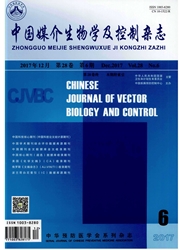

 中文摘要:
中文摘要:
目的研究日本血蜱传播田鼠巴贝西虫的能力。方法用日本血蜱幼蜱、若蜱和成蜱叮咬田鼠巴贝西虫阳性BALB/c小鼠,收集饱血蜱,待孵化为下一个龄期或产卵后,利用巢氏PCR法检测幼蜱的感染情况;再用感染性成蜱叮咬阴性NOD/SCID小鼠,定期采集鼠血进行检测,以观察小鼠感染情况。结果幼蜱叮咬阳性小鼠发育为若蜱后,未检出田鼠巴贝西虫感染;若蜱叮咬阳性小鼠发育为成蜱后,8只雌性成蜱检出田鼠巴贝西虫感染,而雄性成蜱未检出田鼠巴贝西虫感染;成蜱叮咬阳性小鼠后,子代幼蜱未检出田鼠巴贝西虫感染。而12只阴性NOD/SCID小鼠被阳性成蜱叮咬后,有2只小鼠感染。结论日本血蜱仅在若蜱-成蜱阶段可经期传播田鼠巴贝西虫,幼蜱-若蜱阶段不能经期传播田鼠巴贝西虫,亦不能经卵传播田鼠巴贝西虫。
 英文摘要:
英文摘要:
Objective To identify the transmission capacity of Babesia microti through Haemaphysalis japonica. Methods The larvae, nymphs, and adults of H. japonica were fed on BALB/c mice infected with B. microti. The engorged ticks were collected and maintained to the next stage. Ticks of the next stage or the offspring larvae were detected by nested PCR. NOD/SCID mice were then infested by adult ticks molting from nymphs that ingested the blood of infective mice, and the blood samples of NOD/SCID mice were then analyzed by PCR. Results None of the nymphs developed from larvae that fed on positive mice tested positive. Among adult ticks developed from nymphs that were exposed to positive mice, 40% of the females and none of the males tested positive. Among the 12 mice infested by infective adults, B. microti was detected in two NOD/SCID. None of the offspring larvae developed from adult ticks that fed on infected mice tested positive. Conclusion Experimental transstadial transmission of H. japonica for B. microti was proved in the nymph to adult route, but neither in the larvae to nymph routes nor transovarial transmission.
 同期刊论文项目
同期刊论文项目
 同项目期刊论文
同项目期刊论文
 期刊信息
期刊信息
